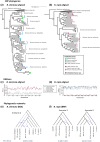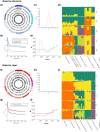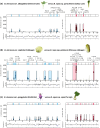Extensive crop-wild hybridization during Brassica evolution and selection during the domestication and diversification of Brassica crops
- PMID: 36810660
- PMCID: PMC10078912
- DOI: 10.1093/genetics/iyad027
Extensive crop-wild hybridization during Brassica evolution and selection during the domestication and diversification of Brassica crops
Abstract
Adaptive genetic diversity in crop wild relatives (CWRs) can be exploited to develop improved crops with higher yield and resilience if phylogenetic relationships between crops and their CWRs are resolved. This further allows accurate quantification of genome-wide introgression and determination of regions of the genome under selection. Using broad sampling of CWRs and whole genome sequencing, we further demonstrate the relationships among two economically valuable and morphologically diverse Brassica crop species, their CWRs, and their putative wild progenitors. Complex genetic relationships and extensive genomic introgression between CWRs and Brassica crops were revealed. Some wild Brassica oleracea populations have admixed feral origins; some domesticated taxa in both crop species are of hybrid origin, while wild Brassica rapa is genetically indistinct from turnips. The extensive genomic introgression that we reveal could result in false identification of selection signatures during domestication using traditional comparative approaches used previously; therefore, we adopted a single-population approach to study selection during domestication. We used this to explore examples of parallel phenotypic selection in the two crop groups and highlight promising candidate genes for future investigation. Our analysis defines the complex genetic relationships between Brassica crops and their diverse CWRs, revealing extensive cross-species gene flow with implications for both crop domestication and evolutionary diversification more generally.
Keywords: Brassica; Plant Genetics and Genomics; crop wild relatives; domestication; introgression; phylogenomics.
© The Author(s) 2023. Published by Oxford University Press on behalf of the Genetics Society of America.
Conflict of interest statement
Conflicts of interest statement The authors declare no conflict of interest.
Figures




Similar articles
-
Brassica rapa Domestication: Untangling Wild and Feral Forms and Convergence of Crop Morphotypes.Mol Biol Evol. 2021 Jul 29;38(8):3358-3372. doi: 10.1093/molbev/msab108. Mol Biol Evol. 2021. PMID: 33930151 Free PMC article.
-
Subgenome parallel selection is associated with morphotype diversification and convergent crop domestication in Brassica rapa and Brassica oleracea.Nat Genet. 2016 Oct;48(10):1218-24. doi: 10.1038/ng.3634. Epub 2016 Aug 15. Nat Genet. 2016. PMID: 27526322
-
Intraspecific diversification of the crop wild relative Brassica cretica Lam. using demographic model selection.BMC Genomics. 2020 Jan 14;21(1):48. doi: 10.1186/s12864-019-6439-x. BMC Genomics. 2020. PMID: 31937246 Free PMC article.
-
Prospects of Feral Crop De Novo Redomestication.Plant Cell Physiol. 2022 Nov 22;63(11):1641-1653. doi: 10.1093/pcp/pcac072. Plant Cell Physiol. 2022. PMID: 35639623 Review.
-
From Evolution to Revolution: Accelerating Crop Domestication through Genome Editing.Plant Cell Physiol. 2022 Nov 22;63(11):1607-1623. doi: 10.1093/pcp/pcac124. Plant Cell Physiol. 2022. PMID: 36018059 Review.
Cited by
-
Genetic Incompatibilities and Evolutionary Rescue by Wild Relatives Shaped Grain Amaranth Domestication.Mol Biol Evol. 2023 Aug 3;40(8):msad177. doi: 10.1093/molbev/msad177. Mol Biol Evol. 2023. PMID: 37552934 Free PMC article.
-
An Unexplored Diversity for Adaptation of Germination to High Temperatures in Brassica Species.Evol Appl. 2025 Mar 9;18(3):e70089. doi: 10.1111/eva.70089. eCollection 2025 Mar. Evol Appl. 2025. PMID: 40066327 Free PMC article.
-
Interploidy Introgression Shaped Adaptation during the Origin and Domestication History of Brassica napus.Mol Biol Evol. 2023 Sep 1;40(9):msad199. doi: 10.1093/molbev/msad199. Mol Biol Evol. 2023. PMID: 37707440 Free PMC article.
-
Population Genomics of Domesticated Cucurbita ficifolia Reveals a Recent Bottleneck and Low Gene Flow with Wild Relatives.Plants (Basel). 2023 Nov 27;12(23):3989. doi: 10.3390/plants12233989. Plants (Basel). 2023. PMID: 38068624 Free PMC article.
References
-
- An H, Qi XS, Gaynor ML, Hao Y, Gebken SC, Mabry ME, McAlvay AC, Teakle GR, Conant GC, Barker MS, et al. Transcriptome and organellar sequencing highlights the complex origin and diversification of allotetraploid Brassica napus. Nat Commun. 2019;10(1):2878. doi:10.1038/s41467-019-10757-1. - DOI - PMC - PubMed
-
- Andrews, S. (2010). FastQC: a quality control tool for high throughput sequence data. http://www.bioinformatics.babraham.ac.uk/projects/fastqc.
Publication types
MeSH terms
LinkOut - more resources
Full Text Sources

